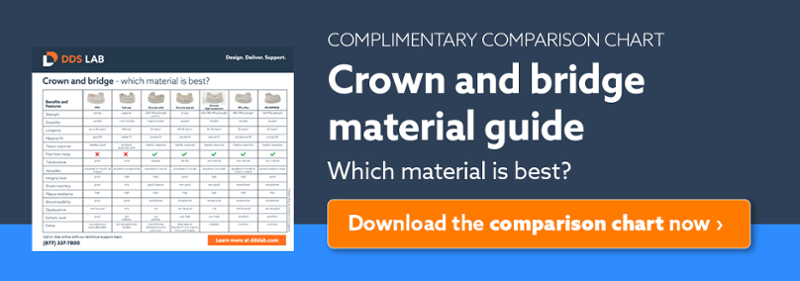When selecting the best type of crown to use with a custom abutment, there are several criteria to consider. Anticipated load, esthetic and biologic requirements, implant angulation, and lastly, depth and the occlusal space must all be planned for. Clinicians must also consider any need for retrievability and their own skills and comfort level.
Custom abutments can be made from titanium, gold-shaded titanium, zirconia, or may have a titanium base with a zirconium superstructure. Alumina abutments are still used but have been largely replaced by zirconia abutments. Titanium abutments are often highly suitable for posterior cases whereas shaded zirconia abutments are ideal for anterior cases and can help to eliminate any problems with graying around the gingival area.
Choices for single-unit crowns include porcelain fused to metal (PFMs), layered and full contour zirconia, e.max, and full gold crowns. Clinicians must also decide whether to use a cement or screw-retained crown. Zirconia or cast alloy screw-retained crowns can be predictably retrieved and the risk of retained cement is eliminated. However, the use of modern connection designs generally means crown retrieval is not normally necessary. Additionally, it is possible to make a slight mark on a cement-retained crown to indicate where the screw is located, in case the crown does need to be drilled for access.

PFMs and Full Gold Crowns
PFMs and full gold crowns are both strong and reliable. Because their strength is not derived from cement, even temporary cement can be used to aid retrievability of the crown. If the anticipated load is high, PFM crowns can be fabricated with metal “stops” in the occlusal surface. However, the gingival margins of PFMs may not be the most aesthetically pleasing, particularly when these crowns are used within the smile line.
e.max Crowns
These lithium disilicate crowns can be extremely strong and may have a strength similar to layered zirconia crowns but ensuring no cement remains subgingivally can be challenging. This is a particularly challenging case when resin cement is used, as the low viscosity and translucency of the cement can make it difficult to thoroughly remove around the gingival margins. Ideally, resin cement should not be used unless additional strength is needed and it is important to note that this type of cement is not suitable when the margin is more than 1.2mm subgingivally. Care needs to be taken when placing an e.max crown over a custom zirconia abutment as high translucency ingots could result in problems with graying. More aesthetically pleasing results may be obtained by choosing a lower translucency ingot and layering the e.max crown to create a restoration with a more natural “liveliness.”
Full-Contour and Layered Zirconia Crowns
Full-contour zirconia crowns can provide good results and are both strong and durable but very little is known about the long-term effects on enamel. Layered zirconia crowns tend to be more suitable in areas where there is plenty of occlusal clearance and can provide better esthetic results, depending on the skill levels of the technician responsible for layering the porcelain. Both layered and full-contour zirconia crowns can be cemented to the abutment using almost any type of cement on the market.
Clinicians should choose the most appropriate crown based on each patient’s individual needs, as one choice will not suit every patient. The choices available should generally provide good results and ultimately, crown selection may also come down to personal preference.
Please be reminded that should you wish to discuss an implant case in more detail, our experienced technical team is here to assist you.
Click here to schedule a consultation with our technical team »
